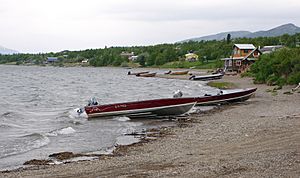Nondalton, Alaska facts for kids
Quick facts for kids
Nondalton, Alaska
Nuvendaltun / Nundaltin
|
|
|---|---|

Nondalton Village on Six Mile Lake
|
|
| Country | United States |
| State | Alaska |
| Borough | Lake and Peninsula |
| Incorporated | May 18, 1971 |
| Area | |
| • Total | 7.01 sq mi (18.16 km2) |
| • Land | 6.74 sq mi (17.45 km2) |
| • Water | 0.27 sq mi (0.70 km2) |
| Elevation | 262 ft (80 m) |
| Population
(2020)
|
|
| • Total | 133 |
| • Density | 19.74/sq mi (7.62/km2) |
| Time zone | UTC-9 (Alaska (AKST)) |
| • Summer (DST) | UTC-8 (AKDT) |
| ZIP code |
99640
|
| Area code | 907 |
| FIPS code | 02-55030 |
| GNIS feature ID | 1407129 |
Nondalton is a small town located in Alaska, United States. It sits on the western shore of Six Mile Lake. The town's name, Nuvendaltun or Nundaltin, comes from the Dena'ina language. In 2020, about 133 people lived in Nondalton.
Contents
Exploring Nondalton's Location
Nondalton is found in the Lake and Peninsula Borough, Alaska. This area is known for its many lakes and wild nature. The town is located at about 59 degrees North latitude and 154 degrees West longitude.
Land and Water Around Nondalton
The village covers an area of about 7 square miles (18 square kilometers). Most of this area is land, but about 0.27 square miles (0.70 square kilometers) is water. This water includes parts of Six Mile Lake.
People of Nondalton
| Historical population | |||
|---|---|---|---|
| Census | Pop. | %± | |
| 1920 | 69 | — | |
| 1930 | 24 | −65.2% | |
| 1940 | 82 | 241.7% | |
| 1950 | 103 | 25.6% | |
| 1960 | 205 | 99.0% | |
| 1970 | 184 | −10.2% | |
| 1980 | 173 | −6.0% | |
| 1990 | 178 | 2.9% | |
| 2000 | 221 | 24.2% | |
| 2010 | 164 | −25.8% | |
| 2020 | 133 | −18.9% | |
| U.S. Decennial Census | |||
Nondalton first appeared in the U.S. Census in 1920. The original village was about 2 miles north of where it is today. In 1940, the people moved the village to its current spot. Nondalton officially became a town in 1971.
Population Changes Over Time
The number of people living in Nondalton has changed a lot over the years. For example, in 2000, there were 221 people. By 2020, the population had decreased to 133. Most people in Nondalton are Native Americans.
Life in Nondalton Homes
In 2000, there were 68 households in the town. Many of these households had children under 18 living there. The average household had about 3 people. The median age of people in Nondalton was 28 years old.
Nondalton's Past and Present
Nondalton is an Athabascan Indian village. The people living here are mainly from the Tanaina and Iliamna groups. The name "Nondalton" means "lake after lake" in their language. This makes sense because the village is next to a series of lakes.
Why the Village Moved
The village was first recorded in 1909. It was originally on the north shore of Six Mile Lake. However, in 1940, the village moved to its current spot. This move happened because they needed more wood and the old site was getting muddy.
Daily Life and Services
For the people of Nondalton, hunting and fishing are very important ways to get food. The village is run by a tribal council.
Nondalton has some important services for its residents:
- A food store with a post office.
- A public school that teaches students from pre-kindergarten all the way to 12th grade.
- A medical clinic for health care.
- A Russian Orthodox church.
- A fishing lodge for visitors.
- A water purification plant.
Most houses have piped water, but they use septic tanks for sewage. Electricity and phone service are available. Sometimes, the village has to issue a "boil water notice" for drinking water.
Getting Around Nondalton
Nondalton is quite isolated. There are no highways or roads that connect it to other towns. The main way to get in and out of the village is by airplane. There is a small, privately owned airport for single-engine planes.
Local Concerns
One important issue for the village is the proposed Pebble Mine site. This mine would be built near Lake Iliamna, which is close to Nondalton.
Images for kids
See also
 In Spanish: Nondalton para niños
In Spanish: Nondalton para niños




